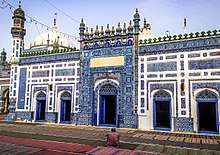Shrine of Shah Abdul Latif Bhittai
| Shrine of Shah Abdul Latif Bhittai | |
|---|---|
شاہ عبداللطیف بھٹائی مزار | |
 The shrine-complex is richly decorated with Sindhi-style tile work | |
| Religion | |
| Affiliation | Islam |
| District | Matiari |
| Province | Sindh |
| Location | |
| Location | Bhit Shah |
| Country | Pakistan |
| Geographic coordinates | 25°48′22″N 68°29′29″E / 25.806005°N 68.4915225°E |
| Architecture | |
| Type | Mosque and Sufi mausoleum |
| Style | Indo-Islamic |
| Completed | 1792 CE |
The Shrine of Shah Abdul Latif Bhittai (Urdu: شاہ عبداللطیف بھٹائی مزار; Sindhi: شاهہ عبداللطيف ڀٽائي جي مزار) is an 18th-century Sufi shrine located in the town of Bhit Shah, in the Pakistani province of Sindh. The shrine is considered to be one of the most important in Sindh, and its annual urs festival attracts up to 500,000 visitors.[1]
Background
The shrine was built for Shah Abdul Latif Bhittai, a noted Sindhi Sufi scholar, mystic, saint, and poet who is widely considered to be the greatest Muslim poet of the Sindhi language.[2] His collected poems were assembled in the compilation Shah Jo Risalo. The shrine is 125 kilometres south of the popular Shrine of Lal Shahbaz Qalandar in Sehwan Sharif.[3]
Women serve as caretakers of tombs within the shrine complex.[4] Male singers at the shrine mimic female voices by singing in falsetto to mimic heroines in Shah Abdul Latif's poetry.[4] The Hindu Bhil and Kolhi communities revere the shrine, as Shah Abdul Latif's poetry is considered to be tolerant of other beliefs.[4]
Building complex


The shrine complex was built in 1772 by Mian Ghulam Shah Kalhoro to house the tomb of the Shah Abdul Latif Bhittai.[5] The shrine complex includes a mosque and a mausoleum that open onto a large courtyard encircled by domed arcades by means of a large gateway. The complex is notable for being elaborately decorated with Sindhi tile work featuring blue and white floral themes.[6] Shah Abdul Latif Bhittai's Surs are performed nightly at the shrine after evening prayers.[4]
Annual festival
The shrine is site of an annual urs festival that attracts up to 500,000 visitors over the course of three days,[1] beginning on the 13th day of the Islamic month of Safar.[7] The festival commemorates Shah Abdul Latif's death by means of celebration, as his death is regarded to be a union with God.[8]
See also
References
- ^ a b Khan, Mohammad Hussain. "Shah Abdul Latif Bhitai's 272nd urs kicks off in Bhit Shah". Dawn. Retrieved 4 March 2017.
The shrine witnesses a turnout of close to 500,000 devotees including foreigners during the three days.
- ^ "saintsofislam". saintsofislam.com. Retrieved 4 March 2017.
- ^ "Map of the distance between Sehwan Sharif and Bhit Shah". Open Street. OSM. Retrieved 4 March 2017.
- ^ a b c d Abbas, Shemeem Burney (2010). The Female Voice in Sufi Ritual: Devotional Practices of Pakistan and India. University of Texas Press. p. 34. ISBN 9780292784505.
- ^ Ahmed, Vaqar (10 April 2015). "Bhit Shah: After the dhamaal". Dawn. Retrieved 4 March 2017.
- ^ Said, Farida (27 March 2015). "Tradition of the tile". Herald Magazine. Retrieved 4 March 2017.
- ^ "Spiritual colours of Shah Abdul Latif Bhitai". Dawn. 15 November 2016. Retrieved 4 March 2017.
- ^ "Shah Abdul Latif Bhitai's 272nd urs kicks off in Bhit Shah". Dawn. 27 November 2015. Retrieved 4 March 2017.
- Use dmy dates from April 2020
- Coordinates on Wikidata
- Articles containing Urdu-language text
- Articles containing Sindhi-language text
- Commons category link is on Wikidata
- Cultural heritage sites in Sindh
- Matiari District
- Mausoleums in Sindh
- Religious buildings and structures in Sindh
- Sufi shrines in Pakistan
- Tourist attractions in Sindh
- Shah Abdul Latif Bhittai

